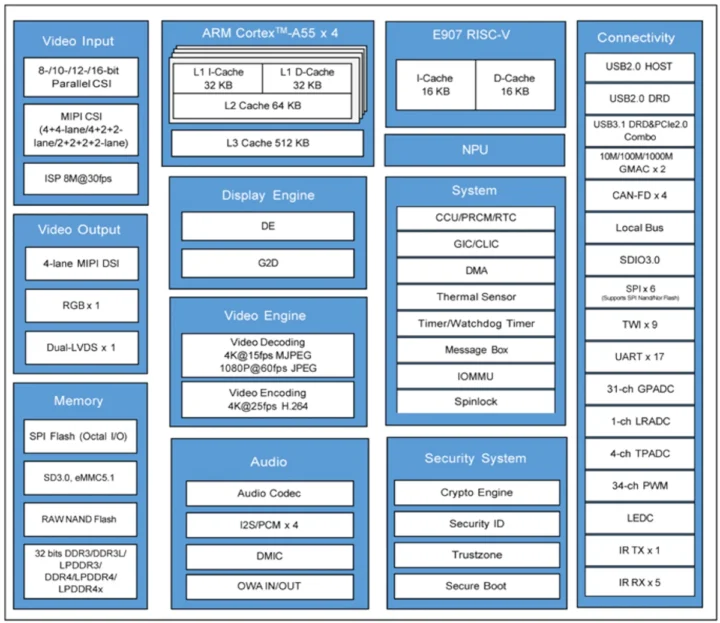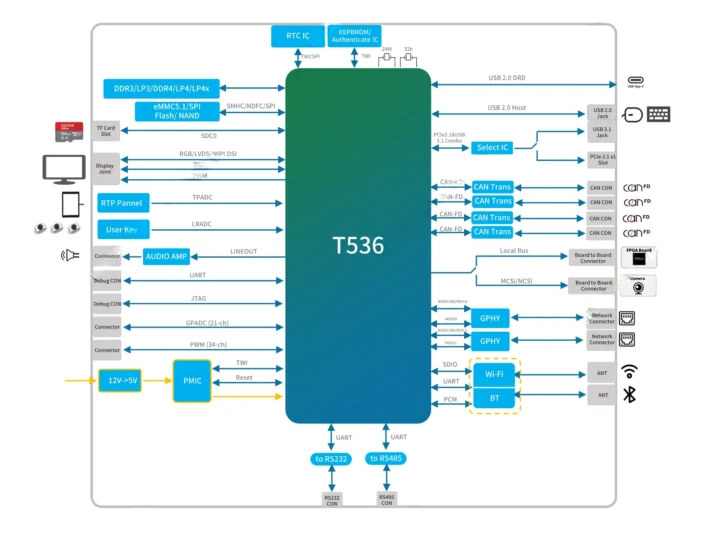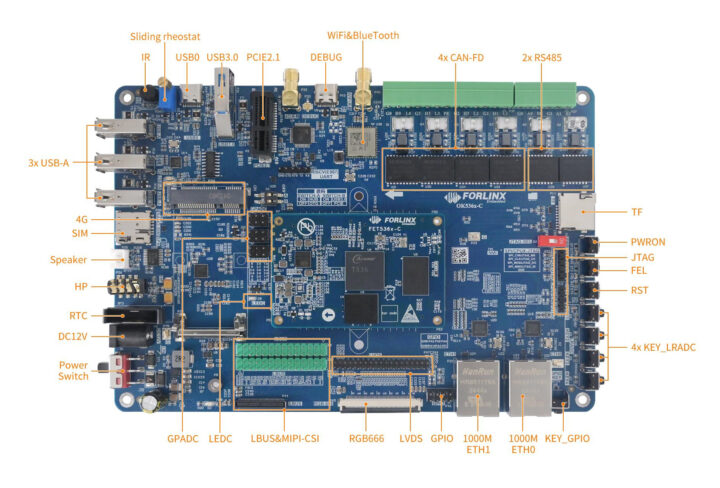Allwinner T536 SoC features four Cortex-A55 cores, a 600 MHz RISC-V core, and a low-power RISC-V for power management, as well as support for ECC memory and an optional NPU with up to 3 TOPS of AI performance.
The processor is designed to work in the industrial temperature range (-40 to +85°C) and offers plenty of I/Os, including two Gigabit Ethernet, a USB 3.1 DRD and PCIe Gen2 conbo, MIPI DSI, RGB, and LVDS display interfaces, paralle CSI and MIPI CSI camera interfaces, CAN FD, SPI, I2C, UART, several ADC, and more. The SoC is designed for interactive terminals, smart manufacturing, and other Edge AI industrial equipment.

Allwinner T536 specifications:
- CPU cores
- Quad-core Arm Cortex-A55 @ up to 1.6GHz
- Single-core E907 RISC-V core @ up to 600 MHz
- Single-core E902 RISC-V MCU for low-power management
- GPU – G2D hardware accelerator with rotate, mixer, and scaler functions
- ISP
- Max resolution – 4800 x 4224 (offline), 2688 x 4224 (online)
- Max frame rate – 8M @ 30fps (offline), 5M @ 30fps (online)
- VPU
- Video Decoder
- MJPEG up to 4K @ 15fps
- (M)JPEG up to 1080p @ 60fps
- Video Encoder
- H.264 up to 4K @ 25fps
- MJPEG up to 4K @ 15fps
- JPEG up to 8K x 8K resolution
- Video Decoder
- NPU – Optional, up to 3 TOPS
- Memory – 32-bit DDR3/DDR3L/LPDDR3/DDR4/LPDDR4/LPDDR4x interfaces
- Up to 8GB RAM without ECC
- Up to 6GB RAM with inline ECC (on selected SKUs see below)
- Storage
- SDIO 3.0, eMMC 5.1, SPI NOR/NAND Flash, and RAW NAND Flash for boot
- ECC protection for SD3.0 and eMMC5.1
- 8-bit parallel NAND flash interface with maximum 80-bit/1KB BCH
- Display Interfaces
- 4-lane MIPI-DSI up to 1920 x 1200 @ 60fps
- Dual-channel LVDS up to 1920 x 1080 @ 60fps
- RGB with DE/SYNC mode up to 1920 x 1200 @ 60fps
- Video Input
- 8/10/12/16-bit parallel CSI with support for BT.656 up to 4x 720p30, BT.601, BT.1120 up to 4x 1080p30, and Digital Camera (DCF) protocol
- 4+4-lane, 4+2+2-lane, or 2+2+2+2-lane MIPI CSI up to 8M @ 30fps
- Audio
- 1x DAC
- 1x LINEOUTP/N audio output
- 4x I2S/PCM interfaces up to 16 channels, 8kHz-384kHz, 8-32-bit width
- Up to 8 digital PDM microphones (DMIC)
- 1x OWA input, 1x OWA output
- Networking – 2x Gigabit Ethernet (GMAC) with RGMII/RMII interfaces
- USB
- 1x USB3.1 DRD (multiplexed with PCIe 2.1)
- 1x USB 2.0 DRD, 1x USB2.0 Host
- PCIe – PCIe 2.1 with RAS DP (Data Protection) for RAMs using ECC (multiplexed with USB 3.1)
- Other peripherals
- 4x CAN-FD, 1x Local Bus
- 17x UART, 9x TWI (I2C), 6x SPI, 34-channel PWM
- Analog – 4-ch TPADC (can be used by GPADC). 1-channel LRADC, 21-ch (specs) or 31-ch (diagram) GPADC
- Infrared – 5x IR Rx, 1x IR Tx
- LEDC (LED Controller?)
- Security
- AES, DES, 3DES, and SM4 encryption and decryption algorithms
- MD5, SHA, and SM3 hash algorithms
- RSA, ECC, SM2 signature/verification:
- 160-bit PRNG (175-bit seed), 256-bit TRNG
- 2048-bit eFuse for chipID and security
- Power Management – Via Allwinner Power Management IC (PMIC)
- Package – ED-FCCSP, 533 balls, 15mm × 15mm, 0.5mm ball pitch, 0.3mm ball size
- Process – 22nm ULP
- Temperature Range – -40°C to 85°C (industrial grade)

Four SKUs are available with different NPU/ECC configurations.
- T536MX-CEN3 – Up to 3 TOPS NPU, ECC memory support
- T536MX-CEN2 – Up to 2 TOPS NPU, ECC memory support
- T536MX-CEX – No NPU, ECC memory support
- T536MX-CXX – No NPU, No ECC memory support
The product page on the Allwinner website has limited details, and I found most of the information in the product brief shared on a Russian website. There’s no information about software there, but MYiR Tech and Forlinx have already launched two Allwinner T536 system-on-modules with the MYC-LT536 and FET536-C and their respective development boards.

That means we have (some) details about the software. Both companies provide a Linux 5.10 SDK with all drivers, but it’s not made publicly available. As a side note, Linux 5.10 was released in December 2020, and it’s scheduled to be supported until December 2026. RT-Thread 5.0 RTOS also supports the Allwinner T536 (first GitHub repository from Forlinx), and I assume it’s running on the 600 MHz E907 RISC-V core rather than the Cortex-A55 cores.

Jean-Luc started CNX Software in 2010 as a part-time endeavor, before quitting his job as a software engineering manager, and starting to write daily news, and reviews full time later in 2011.
Support CNX Software! Donate via cryptocurrencies, become a Patron on Patreon, or purchase goods on Amazon or Aliexpress





About half a year ago allwinnertech website design was updated for first time,
and this SoC – T536 was added.
It’s first sunxi SoC that *claims* ECC
USB3 and PCIe can’t function both, it’s one or the other?
Single cluster of 4 identical cores is better, other combos seems like marketing gimmick.
Good luck sunxi devs!
I’ve been waiting since about mid-December 2024 for the product brief, and I only found it today…
“inline ECC”? Boo… 😐
I’ve been waiting forever for an embedded SBC with ECC RAM (which of course needs a SoC with ECC RAM support), but if this “inline ECC” is anything like Intel’s IBECC (In-Band ECC) with its horrible performance impact, it would mean a sure “thank you but no thank you” from me…